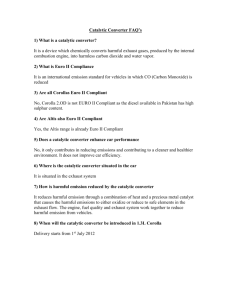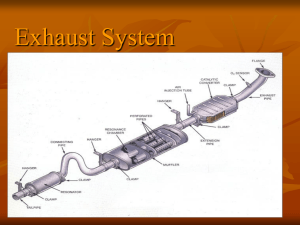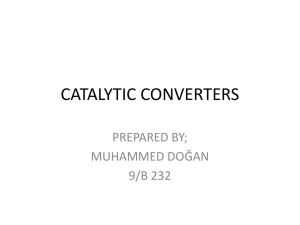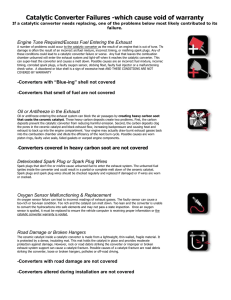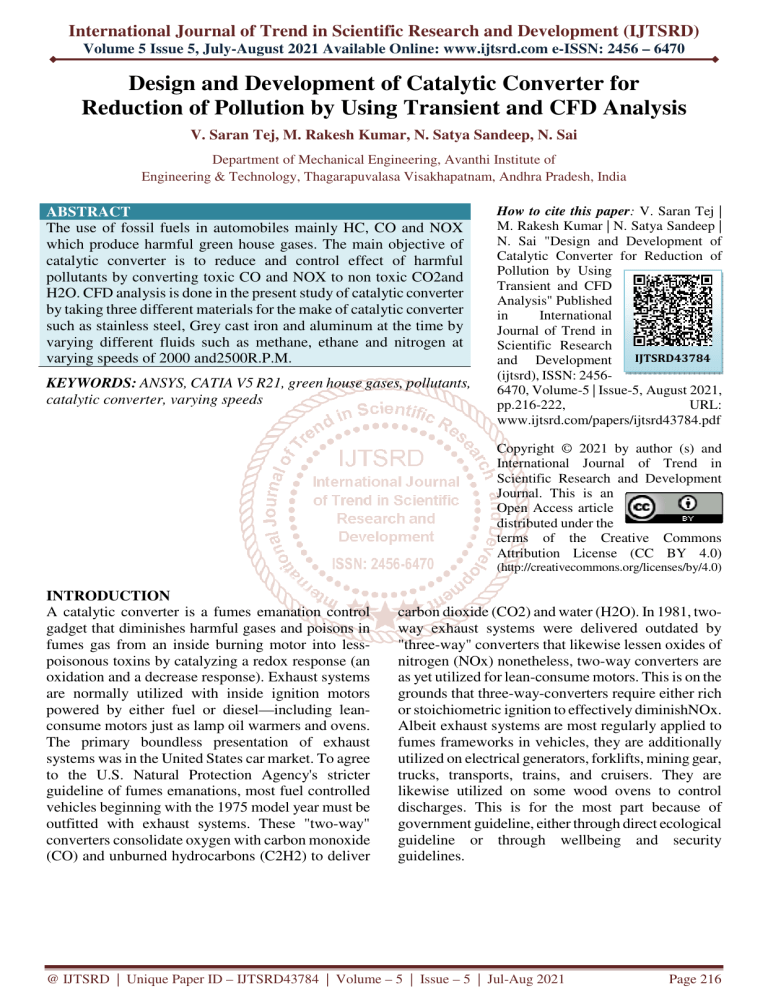
International Journal of Trend in Scientific Research and Development (IJTSRD)
Volume 5 Issue 5, July-August 2021 Available Online: www.ijtsrd.com e-ISSN: 2456 – 6470
Design and Development of Catalytic Converter for
Reduction of Pollution by Using Transient and CFD Analysis
V. Saran Tej, M. Rakesh Kumar, N. Satya Sandeep, N. Sai
Department of Mechanical Engineering, Avanthi Institute of
Engineering & Technology, Thagarapuvalasa Visakhapatnam, Andhra Pradesh, India
ABSTRACT
The use of fossil fuels in automobiles mainly HC, CO and NOX
which produce harmful green house gases. The main objective of
catalytic converter is to reduce and control effect of harmful
pollutants by converting toxic CO and NOX to non toxic CO2and
H2O. CFD analysis is done in the present study of catalytic converter
by taking three different materials for the make of catalytic converter
such as stainless steel, Grey cast iron and aluminum at the time by
varying different fluids such as methane, ethane and nitrogen at
varying speeds of 2000 and2500R.P.M.
KEYWORDS: ANSYS, CATIA V5 R21, green house gases, pollutants,
catalytic converter, varying speeds
How to cite this paper: V. Saran Tej |
M. Rakesh Kumar | N. Satya Sandeep |
N. Sai "Design and Development of
Catalytic Converter for Reduction of
Pollution by Using
Transient and CFD
Analysis" Published
in
International
Journal of Trend in
Scientific Research
IJTSRD43784
and Development
(ijtsrd), ISSN: 24566470, Volume-5 | Issue-5, August 2021,
pp.216-222,
URL:
www.ijtsrd.com/papers/ijtsrd43784.pdf
Copyright © 2021 by author (s) and
International Journal of Trend in
Scientific Research and Development
Journal. This is an
Open Access article
distributed under the
terms of the Creative Commons
Attribution License (CC BY 4.0)
(http://creativecommons.org/licenses/by/4.0)
INTRODUCTION
A catalytic converter is a fumes emanation control
gadget that diminishes harmful gases and poisons in
fumes gas from an inside burning motor into lesspoisonous toxins by catalyzing a redox response (an
oxidation and a decrease response). Exhaust systems
are normally utilized with inside ignition motors
powered by either fuel or diesel—including leanconsume motors just as lamp oil warmers and ovens.
The primary boundless presentation of exhaust
systems was in the United States car market. To agree
to the U.S. Natural Protection Agency's stricter
guideline of fumes emanations, most fuel controlled
vehicles beginning with the 1975 model year must be
outfitted with exhaust systems. These "two-way"
converters consolidate oxygen with carbon monoxide
(CO) and unburned hydrocarbons (C2H2) to deliver
carbon dioxide (CO2) and water (H2O). In 1981, twoway exhaust systems were delivered outdated by
"three-way" converters that likewise lessen oxides of
nitrogen (NOx) nonetheless, two-way converters are
as yet utilized for lean-consume motors. This is on the
grounds that three-way-converters require either rich
or stoichiometric ignition to effectively diminishNOx.
Albeit exhaust systems are most regularly applied to
fumes frameworks in vehicles, they are additionally
utilized on electrical generators, forklifts, mining gear,
trucks, transports, trains, and cruisers. They are
likewise utilized on some wood ovens to control
discharges. This is for the most part because of
government guideline, either through direct ecological
guideline or through wellbeing and security
guidelines.
@ IJTSRD | Unique Paper ID – IJTSRD43784 | Volume – 5 | Issue – 5 | Jul-Aug 2021
Page 216
International Journal of Trend in Scientific Research and Development @ www.ijtsrd.com eISSN: 2456-6470
changes over hydrocarbons and carbon monoxide into
carbon dioxide and water; and a decrease response of
nitrogen oxides to create unadulterated nitrogen.
Carbon monoxide is a toxic substance for any airbreathing creature. The catalytic converter systems
As the inward ignition motor uses the fumes stroke to
remove the' spent' gases by means of the fumes
System, the hurtful emanations are gone through an
uncommon suppressor type looking gadget called an
exhaust system. After the discharges have gone
through the Converter they are gone through their s of
the fumes framework in the ordinary way lastly to
environment. The exhaust systems object is to lessen
the first unsafe outflows to unimportant levels by
methods for impetus controlled synthetic responses.
Inside the structure of the exhaust system is a
structure using an impetus.
Figure 1 A three-way catalytic converter
The emissions of a vehicle engine
Were first planned in France toward the finish of the
nineteenth century, when a couple thousand "oil
vehicles" were on the streets; it was comprised of a
latent material covered with platinum, iridium, and
palladium, fixed into a twofold metallic chamber. A
couple of many years after the fact, an exhaust system
was licensed by Eugene Houdry, a French mechanical
specialist and master in reactant oil refining, who
moved to the United States in 1930. At the point
when the aftereffects of early investigations of brown
haze in Los Angeles were distributed, Houdry got
worried about the function of smokestack fumes and
vehicle exhaust in air contamination and established
an organization called Oxy-Catalyst. Houdry
originally created exhaust systems for smokestacks
called "felines" for short, and later created exhaust
systems for distribution center forklifts that preowned second rate, unleaded fuel. During the 1950s,
he started exploration to create exhaust systems for
gas motors utilized on vehicles. From the synthetic
perspective, an impetus is any substance ready to
quicken a compound response while keeping up its
own personal structure. On account of cars, Converter
where a practically complete debasement of fumes
smoke can be accomplished by synergist responses
over a hyperactive zone made of platinum and
rhodium. Notwithstanding its humble volume, the
dynamic surface region inside an exhaust system
would cover two football fields Inside the engine, a
cylinder pushes lingering hot gases from the burning
chamber to the fumes valve, and when these gases go
through the dynamic territories inside the earthenware
cells of the converter, two inverse compound cycles
happen all the while: an oxidation response which
Figure 2.The catalytic converter systems
Catalytic conversion is a three stage process
1. The ReductionCatalyst: This stage comprises of
diminishing the emanations of nitrogen oxides by
utilizing platinum and rhodium.
2. The OxidationCatalyst: The second phase of the
cycle diminishes the unburned hydrocarbons and
carbon monoxide by consuming them over a
platinum and palladium impetus.
3. The ControlSystem: The control framework
essentially screens the fumes stream and takes
this data to control the fuel infusion framework.
To do this, the exhaust system is outfitted with an
oxygen sensor that tells the motor's PC how
muchoxygen is in the fumes. This permits the
motor's PC to ensurethatthere is sufficient oxygen
in the fumes to permit the oxidization impetus to
consume the unburned hydrocarbons andCO.
Components of the catalytic converter
There are three primary segments of the Catalytic
Converter:
The Monolith (otherwise called the substrate), a fired
or metal structure built like a honeycomb, through
which fumes gases pass. Wash coat, permeable fired
wipe like coatings applied in a dainty layer to the stone
monument that increases the surface region to that of
@ IJTSRD | Unique Paper ID – IJTSRD43784 | Volume – 5 | Issue – 5 | Jul-Aug 2021
Page 217
International Journal of Trend in Scientific Research and Development @ www.ijtsrd.com eISSN: 2456-6470
around two football pitches, over which the reactant
metals can bekept. The Catalyst, typically comprising
of a combination of Platinum and Rhodium in spite of
the fact that Palladium is additionally utilized They
complete the synthetic responses that purge the fumes.
The catalytic converter operates under the
following conditions
Working temperature
The impetus begins working once the stone monument
has achieved a temperature of 250-270°C, the
temperature (usually known as light-off) which a
vehicle will ordinarily reach from cold beginning
inside a couple of moments. Under typical working
conditions the impetus keeps up a temperature of
between 400-600°C. To work most viably, an exhaust
system needs to arrive at an ideal temperature. It may
not arrive at this in a short excursion. Devises to prewarm the impetus are being created which improve
the general presentation of exhaust systems.
Reactions in a Catalytic Converter
It isn't decisively seen how platinum and rhodium
function as impetuses however actually, the exhaust
systems activity includes two sorts of responses: Oxidation Reaction. - Reduction Reaction. Oxidation
Reaction: In a Catalytic Converter unburned
hydrocarbons are Oxidized to water and carbon
dioxide. Decrease Reaction: nitrogen oxides are
diminished once more into nitrogen, the significant
part of air. The impetus in this chamber makes this
conceivable. The converter utilizes two distinct kinds
of impetuses, a decrease impetus and an oxidation
impetus. The Catalyst, typically comprising of a
combination of Platinum and Rhodium in spite of the
fact that Palladium is additionally utilized They
complete the synthetic responses that purge the fumes.
Amount of impetuses utilized
Platinum or Palladium quicken the oxidation of
hydrocarbons and carbon monoxide, while Rhodium
decreases the oxides of nitrogen when in doubt there
are just between 1-2 grams of valuable metals in each
exhaust system The thought is to make a structure that
uncovered the most extreme. surface region of
impetus to the fumes stream, while additionally
limiting the measure of impetus required (they are
extravagant).
The catalytic converters type
There are three basic types of automotive catalytic
converters
Figure 3 Basic types of automotive catalytic
converters
Each type utilizes a somewhat unique strategy and
science to decrease the destructive components in
exhaust discharges. Early model converters utilized a
palletized impetus, yet most modem converters are
currently planned with a free streaming honeycomb
fired impetus. The sort of converter needed on a
specific vehicle differs with model year, motor size
and vehicle weight. A few vehicles even utilize more
than one sort of converter or a pre converter to fulfill
discharge decrease guidelines.
Two-Way Oxidation Converter
A Two-Way converter, utilized on vehicles between
1975 - 1980, oxidizes unburned hurtful hydrocarbons
and carbon monoxide into water and carbon dioxide.
Figure 4 Two-Way Oxidation Converter
METHODOLOGY
Figure 5 Fluid: Nitrogen At engine speed-2000
RPM
@ IJTSRD | Unique Paper ID – IJTSRD43784 | Volume – 5 | Issue – 5 | Jul-Aug 2021
Page 218
International Journal of Trend in Scientific Research and Development @ www.ijtsrd.com eISSN: 2456-6470
Figure 11.Mass weighted average velocity
Similar way the mass flow rate and mass weighted for
Ethane and methane at different speeds are
determined and tabulated
Steady state thermal analysis of catalytic Convertor
Figure 6 Meshing
Figure 12 Temperature distribution for steel
Figure 7 Boundaries for inlet and outlet
Figure 8 Velocity at 2000rpm for nitrogen
Figure 13 Temperature distribution for
Aluminium
Figure 9 Pressure at 2000rpm for nitrogen
Figure 14.Heat Flux Distribution
Unsteady state/transient thermal analysis of catalytic
convertor
Figure 10.Mass flow rate at 2000rpm for
nitrogen
Figure 15.Heat flux Distribution for steel
@ IJTSRD | Unique Paper ID – IJTSRD43784 | Volume – 5 | Issue – 5 | Jul-Aug 2021
Page 219
International Journal of Trend in Scientific Research and Development @ www.ijtsrd.com eISSN: 2456-6470
Figure 16.Temperature Distribution for steel
Similar way the heat flux and temperature distribution are determined and tabulated
RESULTS
Table 1 CFD analysis
fluid
Engine speed(rpm) pressure (pa) velocity (m/s)
2000
7.27e+04
2.34e+01
Nitrogen
2500
9.20e+04
2.84e+01
2000
4.28e+04
2.15e+01
Ethane
2500
5.49e+04
2.64e+01
2000
4.69e+04
2.35e+01
Methane
2500
5.93e+04
2.85e+01
Table 2.Mass Flow Rate
mass flow rate(kg/s)
Fluid engine speed(rpm)
inlet
outlet
interior substrate body
2000
0.003807
-0.000428015
0.07926
nitrogen
2500
0.0047605
-0.00052024
0.099029
2000
0.004226233 -0.00048097
0.087718678
ethane
2500
0.005283423 -0.000562752
0.10954842
2000
0.002234918 -0.00024676
0.046537671
methane
2500
0.002793981 -0.000307021
0.05814116
net flow rate
0.0033799
0.0042402
0.003745264
0.004720671
0.001988158
0.00248696
Table 3.Mass weighted average velocity
mass weighted average velocity(m/s)
fluid
engine speed(rpm)
inlet
outlet
interior substrate body net flow velocity
2000
16.75 2.297265
2.98539
3.5809
nitrogen
2500
20.94 2.778597
3.37356803
4.471905
2000
16.75 2.241589
3.2272637
3.799628
ethane
2500
20.94 2.61301
4.0376501
4.750803
2000
16.75 2.260191
3.2098696
3.794471
methane
2500
20.94 2.806969
4.0161152
4.744567
Steady state thermal analysis
Table 4.Temperature
temperature
material
min
max
stainless steel 180.56 350.05
grey cast iron 278.06
350
aluminum
324.74
350
heat flux
1.2536
1.7444
1.9519
@ IJTSRD | Unique Paper ID – IJTSRD43784 | Volume – 5 | Issue – 5 | Jul-Aug 2021
Page 220
International Journal of Trend in Scientific Research and Development @ www.ijtsrd.com eISSN: 2456-6470
Table 5.Unsteady state thermal analysis results
temperature (0C)
Heat flux(w/mm2)
Marterials time (sec)
min
max
10
81.856 150.72
0.81549
stainless steel
20
133.49 259.03
0.84599
30
177..17 350.98
1.253
10
120.63 150.04
0.81759
20
198.64 250.04
1.2487
Grey cast iron
30
276.07 350.05
1.8
10
139.61 150.01
0.89796
20
232.34 250.01
1.5106
aluminum
30
324.51 350.01
2.1574
Graphs
1.00E+05
2000
9.00E+04
2500
8.00E+04
7.00E+04 e
5.00E+04
4.00E+04
3.00E+04
2.00E+04
1.00E+04
0.00E+00
Nitrogen
ethane
methane
Figure 14 Pressure
3.00E+01
2000
2500
Rpm
2.50E+01
2.00E+01
1.00E+01
5.00E+00
1.50E+01
0.00E+00
nitrogen
ethane
methane
Figure 17.Velocity
@ IJTSRD | Unique Paper ID – IJTSRD43784 | Volume – 5 | Issue – 5 | Jul-Aug 2021
Page 221
International Journal of Trend in Scientific Research and Development @ www.ijtsrd.com eISSN: 2456-6470
2.
2
1.
5
TIME (SECONDS)10
TIME (SECONDS)20
TIME (SECONDS)30
0.
0
STAINLESS STEEL GREYCASTIRON
Figure 18.Unsteady state thermal analysis (Heat flux)
CONCLUSION
In this thesis, a catalytic converter is designed and
developed for reduction in hazardous effluents. The
catalytic converter is designed in CATIA V5 and
analyzed by using CFD(Fluent) for three different
materials which are Stainless Steel, Grey cast iron,
Aluminium alloy at a time on different blended fluids
Nitrogen and Air, Ethane and Methane at engine
speeds 2000RPM, 2500RPM.It is observed from
Steady and Transient state thermal Analysis Heat flux
is less for Stainless steel than that of grey cast iron
and aluminium and also it is observed from CFD
analysis pressure and velocity are less in Ethane
compared to other two gases at different speeds i.e
2000RPM and 2500RPM.The catalytic converter
reduces the amount of both CO and HC while
increase in the amount of carbon dioxide and it has
been observed that reduction in pollutants in exhaust
gases is more at 2000RPM.
REFERENCES
[1] Prof. Bharat S Patel, Mr. Kuldeep D Patel; A
Review paper on Catalytic Converter for
Automotive Exhaust Emission; International
Journal of Applied Engineering Research,
ISSN: 0973-4562, Vol. 7 No. 11, (2012).
[2]
Jay M. Parmar, Prof. Keyur, D. Tandel;
Performance of Limestone Coated Wire mesh
Catalytic Converter for Emission Control of C.
I Engine; International Journal for Scientific
Research and Development (IJSRD); ISSN
(online): 2321-0613, Vol. 1, Issue 11 (2014).
[3]
Md. Mizanuzzaman, Amitava Ghosh Dastidar,
Mohammad Rajib Uddin Rony, Reasat Azam,
Md. Almostasim Mahmud; Exhaust Gas
Analysis of SI Engine and Performance of
Catalytic Converter; International Journal of
Engineering Research and Applications
(IJERA) ISSN: 2248- 9622; Vol. 3, Issue 4,
pp:313-320, Jul-Aug 2013.
[4]
Chirag Amin, Pravin P. Rathod; Catalytic
Converter Based on Non-Noble Material;
International Journal of Advanced Engineering
Research and Studies (IJAERS); E-ISSN: 22498974, Vol. I, Issue II, January-March (2012),
p:118-120.
[5]
Julie M Pardiwala, Femina Patel, Sanjay Patel;
Review Paper on Catalytic Converter for
Automotive Exhaust Emission; International
Conference On Current Trends in Technology,
'NUiCONE-2011'.
[6]
B. P. Pundir, Engine Emissions: Pollutant
Formation and Advances in Control
Technology, Chapter 4, pp. 115-155.
[7]
P. Bera, and M. S. Hegde, "Late advances in
auto fumes catalysis", Journal of the Indian
Institute of Science, vol. 90:2, pp. 299-325,
2010.
@ IJTSRD | Unique Paper ID – IJTSRD43784 | Volume – 5 | Issue – 5 | Jul-Aug 2021
Page 222


